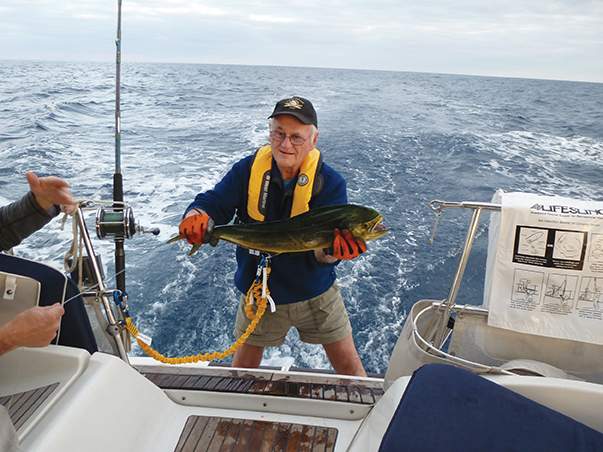Headed offshore to the Caribbean or Mexico this winter? Here are the basics for preparing your boat and crew for the rigors of an autumn ocean passage (published October 2014)
The old adage among experienced skippers when it comes to getting ready to make an offshore passage is to mind the Three Ps. They are: Planning, Preparation and Practice. As fall approaches and skippers and crews get their boats ready to sail south and perhaps join a rally such as the Salty Dawg Rally, NARC, Caribbean 1500 on the East Coast or the Baja Haha on the West Coast, they all have to think about the weather conditions and full range of possibilities and emergencies that they may have to face during a long offshore passage.
East Coast passages south entail sailing in the storm swept North Atlantic in November, crossing the Gulf Stream and then crossing the Intertropical Convergence Zone (ITCZ), where you can find both calms and sudden fierce squalls. As a rule during the fall after the hurricane season has passed you will find low pressure systems moving off the coast, often just south of Hatteras, every four days or so and if one is moving slowly, the systems can combine creating a week or more of ugly weather. Finding a weather window gets more difficult the later in the year it gets.
On the West Coast, the weather systems are more benign and you are normally making a long coastal run where there are bail out ports when the weather turns nasty. So, the passage south to Mexico is not as fraught with weather issues as the run from the East Coast to the Caribbean.
But both passages south are blue water sailing and each skipper and crew needs to plan, prepare and practice accordingly.
PLANNING
Planning is what makes anything as complicated as undertaking a long offshore passage possible and the plans have to cover both the big picture and the details that cover every contingency.
The big picture is the choice of the route and the season of departure. For most of us, the season or departure date will be dictated by the end of the hurricane seasons in the Atlantic and Pacific . Plus, your insurance company will have their restrictions on when you depart. For the most part, the end of October and early November will be the weeks when most boats get underway.
On the East Coast, you may opt to sail to Bermuda earlier in the fall when no hurricanes are lurking and when the frequency of North Atlantic gales is lower than in November. You can then explore Bermuda at a lovely time of year while you wait until November and the insurance deadline to make the passage south to the Caribbean. Or, if you are bound for the Bahamas, you might make your way to ports south of Hatteras, such Beaufort, N.C. or Charleston, and then wait for a nor’westerly clearing breeze to blow you across the Gulf Stream and push you south towards a landfall in the Abacos.
On the West Coast you may opt to day sail most of the way to Cabo San Lucas or make the trip in a series of short overnight hops. This is what the 100 plus boats in the Baja Haha do with riotous parties held at each of the stopovers. Or, you might want to tackle the trip from Southern California to Cabo in one longer passage. Either way, Cabo is most often the staging point for boats sailing into and out of the Mexican cruising grounds.
With your route and schedule inked into the calendar, you then need to think about your Plan B and C. If things go wrong in the middle of Plan A, where you can seek shelter and aid at various points along your planned route. If you are headed to the B.V.I from the Chesapeake Bay, you need to have onboard the charts and radio frequencies for Bermuda and the Bahamas.
Planning also is vital for all of your onboard systems, safety gear, living condition and health. You need to plan how you will keep your crew on the boat and retrieve them if they go over the side. You need to plan how to keep the rig up and have the tools and spares to make a jury rigged mast if you need to. The list goes on. But you need to make the lists in order to plan for every contingency. Like every skipper preparing for the first “Big One,” you will need a list of all your lists!
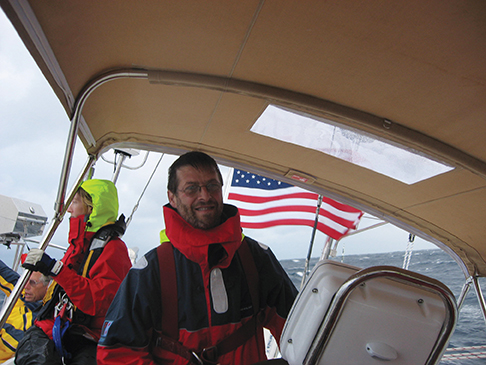 PREPARATION
PREPARATION
New passagemakers will find that it can take up to a year to get their boats fully prepared for a well planned and safe career as a blue water sailor. But, once you have achieved this level of preparation and have made a number of passages, the whole process of getting ready to get away becomes a whole lot simpler and less expensive. Depending on how well equipped your boat is at the outset, it can cost up to 25 percent of the boat’s value to equip it with the gear you need and want.
There are good resources out there that will give you a clear idea of what the most experienced offshore sailors consider the required gear for passagemaking. One of the best is the International Sailing Federation’s (ISAF) Special Regulations for Offshore Events. It is available through the U.S. Sailing online store and worth every penny.
Start with the basics. Make sure the hull and deck joint are sound and watertight. Make sure the keel is permanently attached to the boat and that the rudder and bearings are sound. Hiring a marine surveyor to do a thorough inspection is money well spent.
Next, go over every piece of the mast, boom, rigging and sails. Look for cracks, wear, chafe and anything that looks suspect. Telltale barber-poling on wire shrouds indicates weakness. Excessive play in a roller furling unit can mean the furler’s joints are loose and prone to failure. Hire a rigger to go over the rig and replace any stays that cause the slightest doubt. On voyaging boats, stays need to be replaced at regular intervals depending on their size relative to the size of the rig. Sails need to be in excellent condition if you are heading offshore, and spare sails and sail patching kits should be aboard any cruising boat.
Steering systems are vulnerable, particularly on more modern spade rudder designs. Thoroughly inspect and upgrade all of the moving parts of the steering system and make sure you carry spare cables, bull dog clamps, stainless thimbles and the knowledge of how to replace a broken steering cable in the dark on a stormy night. And, carry aboard a system for steering your boat if the rudder fails completely (See “Steering Your Boat Without a Rudder” on page 44).
The boat should be equipped with lifejackets for all crewmembers per Coast Guard requirements but most skippers also carry inflatable life vests that meet Category One requirements and double as a safety hardness with a tether. On deck you need to install pad eyes at the helm, next to the companionway and on the foredeck where crew can clip in. And you need to rig jacklines on both side decks when sailing offshore. If the boat does not have an in-mast or in-boom furling mainsail, then installing “sissy bars” on either side of the mast can help those hoisting, lowering and reefing the big sail.
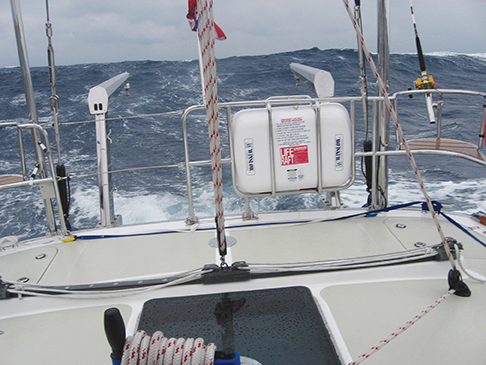 A life raft and ditch kit are essential items on an offshore boat. The life raft should be currently inspected and large enough for the whole crew. The ditch kit needs to have signaling devices such as flares, a VHF radio, a mirror and, it should have food and water for the crew for five days and fishing gear for longer stays.
A life raft and ditch kit are essential items on an offshore boat. The life raft should be currently inspected and large enough for the whole crew. The ditch kit needs to have signaling devices such as flares, a VHF radio, a mirror and, it should have food and water for the crew for five days and fishing gear for longer stays.
Emergency beacons are the modern blue water sailor’s best friend. EPIRBs with a built-in GPS have saved hundred of lives at sea and you shouldn’t go offshore without one. Personal locator beacons do for you what the EPIRB does for the boat; it lets rescuers know exactly where and who you are. PLBs are inexpensive so buy them.
Pumps are too often overlooked but are the basic tools for keeping your boat afloat and you out of the life raft. All modern boats have a manual pump at the helm and an electric pump in the bilge or sump. To this you should add a high capacity emergency electric pump and a large manual pump such as the venerable one sold by Edson. If water is coming in, you don’t have long to find the leak before it is too late.
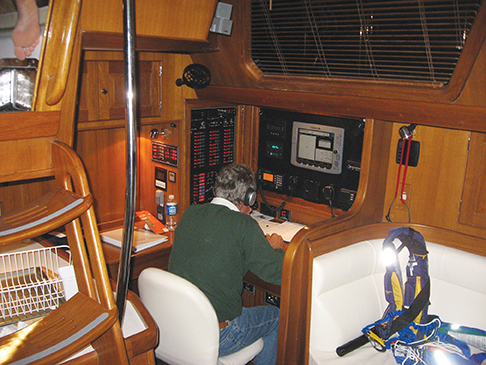 Communications are always high on new cruisers’ lists. Single sideband transceivers (SSBs) are the most common form of communication in the offshore cruising fleets because they work. You can chat with friends and communicate with ships and port captains. You can get weather and send and receive email. And, you can do this for a modest investment and low operating costs.
Communications are always high on new cruisers’ lists. Single sideband transceivers (SSBs) are the most common form of communication in the offshore cruising fleets because they work. You can chat with friends and communicate with ships and port captains. You can get weather and send and receive email. And, you can do this for a modest investment and low operating costs.
Satellite phones have become much less expensive and data capabilities continue to improve. Certainly, more and more cruisers and passagemakers are adding them to their chart tables. But, unless you install a very high quality antenna, you will find that reliability of the sat signal is quite poor at sea. Iridium and INMARSAT have worldwide coverage. Globalstar does not but has a very clear signal and is best in class data transmission.
VHF radios are essential. If you have only one on board it should be in the cockpit and near the helmsman. It is best to have three: one in the cockpit, one at the chart table with DSC capability and a handheld.
Experienced cruisers have learned that redundant methods to steer the boat make offshore sailing much more enjoyable. Today, it is common for boats heading offshore to have two installed autopilots that can be swapped out so one can steer while the other is being repaired. Spare parts are essential. Plus, voyaging boats also often choose to carry a windvane self-steering device that will steer accurately and effortlessly for weeks without consuming an amp of electricity or a meal. As mentioned, you need to have a system in place that will steer the boat without the rudder.
PRACTICE
Too often the third P gets short thrift as a skipper and crew are getting ready for a passage south. The lists of gear to buy and install are seemingly endless. It is a truism that you are never ready to leave, which is why so many boats get stuck in their marina berths forever. One of the benefits of joining a rally is that it sets an arbitrary departure date for you that focuses the mind on getting jobs done.
But, in the process of fitting out the boat for blue water sailing, the time consuming business of actually learning how to use all of our gear and equipment is vitally important before you point the bow toward the horizon.
The more time you spend sailing your boat in a wide variety of conditions, the better sailor you will be and the more competent you will be as a skipper. So, the most important part of the practice phase is to go sailing often and far. Take cruises to nowhere by leaving port on a Friday afternoon, sailing straight offshore for 24 hours and then turning back for a Sunday afternoon landfall in your homeport. Or make 300 miles coastal runs that will take about two days each way. You will be amazed at how much you learn in such a short period of time. And, if you are nervous about making these small steps offshore, hire a professional skipper to come with you the first few times.
Get to know your basic engineering systems well enough so you can undertake routine maintenance and repairs. Take a diesel course offered by companies like Mack Boring. Take your autopilot apart and put it back together again. Rebuild a pump and disassemble and clean your winches.
Figure out how you are going to steer your boat without a rudder and then go out and practice until you know exactly how to set up the system to make the boat perform all of the turns you need.
Every boat heading offshore should have two forms of long-range communications aboard. HF radios and satphones are the most common today. But, you need to know how to use these tools. HF radios are wonderful ways to communicate but they require professional installation and then you need to develop the skills to use them. By the time you head offshore you should be completely competent in the uses of your high seas marine transceiver.
Satphones may seem simpler but in fact the hand held models or those with small antennas can be difficult to use offshore since they tend to lose the satellite signal as the boat rolls and pitches in ocean waves. You need to develop the knowledge and skill to use the phone in those conditions and to master the software you will need for sending emails and text messages. It is not like using a cell phone at home.
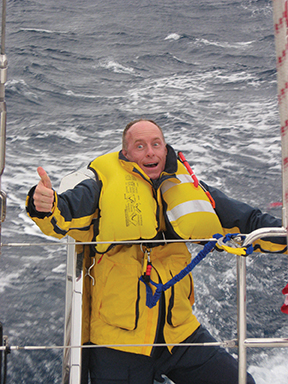
Man overboard is the one emergency you never want to experience but you do need to practice how to retrieve a person who has fallen off the boat. Develop the system you will use and then take your crew out and practice rescuing a floating object using the system. Make sure everyone on the boat can steer and trim as you make your maneuvers.
In the end, as you get ready to head south, you are building skills and becoming both a better sailor and a more competent seaman. You will never learn it all nor will you ever be complete ready to go. That’s why the cruising life and offshore sailing are activities that can keep you engaged for a lifetime.

















